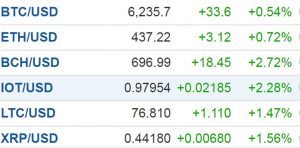Asian Markets are positively bullish Friday morning bolstered by upbeat US consumer sentiment and rebounds from the effects of the Trade Tariffs Threat, (TTT).
The USD reaffirmed its position versus other currencies rallying up to 10-Day highs, brought on by the surging of US yields and expectations of an upbeat Quarterly earnings report from some of the most notable Banks such as Citigroup Inc,(C), JPMorgan Chase & Co, (JPM), Wells Fargo & Co,(WFC),& First Republic Bank,(FRC) to name but a few.

- Global Stocks:
Global stocks are bullish, Asia is up, ripple effects will be seen in Europe, and likely to bounce on to the US
Germany 30 was up 0.22% in a range of 12,517.60 – 12,584.59
France 40 was also up 0.34% trending between 5,421.5 – 5,440.0
Italy 40 rallied 0.27%, while UK100 climbed 0.47% oscillating between 7,683.75 – 7,717.00 at time of print 08:31GMT.
With the USD up other majors are down in classic inverse correlation
EUR/USD down 0.33% 1.1627 – 1.1675
GBP/USD pinned down 0.61%
AUD/USD is also bearish to the USD slipping 0.43% in a range of 0.7368 – 0.7422.
The USD/JPY is raising eyebrows with US piping up from 112.42 – 112.80
Commodities reversed Thursday’s gains in most assets Oil is down and so is Gold. Baker Hughes Rig count on tap
Cryptocurrencies;
Cryptocurrencies are very bullish

Meanwhile, US President Trump continues with his European tour first the NATO, North Atlantic Treaty Organisation Summit followed by with his Official state visit to the UK.
For further details kindly contact your account manager or please visit xtrade.com’ platform.





